| |
|
Xiamen Oil Paintings, Wholesale Direct!
|
|
100% hand painted, 100% cotton canvas, 100% money back if not satisfaction. |
|
|
|
|
ART WORKS INDEX
A
B
C
D
E
F
G
H
I
J
K
L
M
N
O
P
Q
R
S
T
U
V
W
X
Y
Z
|
|
ARTISTS INDEX
A
B
C
D
E
F
G
H
I
J
K
L
M
N
O
P
Q
R
S
T
U
V
W
X
Y
Z
|
|
|
|
|
|
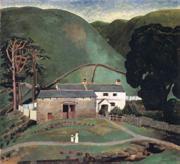 |
Dora Carrington
|
|
British Painter,
1893-1932
English painter and decorative artist. Daughter of a Liverpool merchant, she was brought up in Bedford. She trained at the Slade School of Fine Art in London where she met John Nash, who aroused her interest in wood-engraving, and Mark Gertler, whose powerful figure paintings influenced her own approach to portraiture. She rejected Gertler as a lover and set up home with the homosexual essayist and biographer Lytton Strachey (1880-1932), first at Tidmarsh Mill, near Pangbourne, Berks, then at Ham Spray, between Newbury and Hungerford, Berks. In 1921 she married Ralph Partridge, living with him and Strachey in a m?nage ? trois, surrounded mainly by literary friends and receiving little encouragement to exhibit. She turned instead to decorative work, emulating Vanessa Bell and Duncan Grant but in a style more native in inspiration and more naive. She designed tiles and inn signs, experimented with painting on glass and tinfoil, decorated furniture and designed the library at Ham Spray.
|
|
|
|
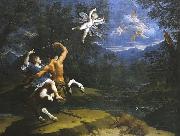 |
Donato Creti
|
|
(1671-1749) was an Italian painter of the Rococo period, active mostly in Bologna.
Born in Cremona, he moved to Bologna, where he was a pupil of Lorenzo Pasinelli. He is described by Wittkower as the "Bolognese Marco Benefial", in that his style was less decorative and edged into a more formal neoclassical style. It is an academicized grand style, that crystallizes into a manneristic neoclassicism, with crisp and frigid modeling of the figures. Among his followers were Aureliano Milani, Francesco Monti, and Ercole Graziani the Younger. Two other pupils were Domenico Maria Fratta and Giuseppe Peroni
|
|
|
|
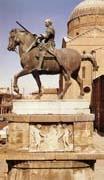 |
Donatello
|
|
Italian Early Renaissance Sculptor, 1386-1466,Italian sculptor. He was the most imaginative and versatile Florentine sculptor of the early Renaissance, famous for his rendering of human character and for his dramatic narratives. He achieved these ends by studying ancient Roman sculpture and amalgamating its ideas with an acute and sympathetic observation of everyday life. Together with Alberti, Brunelleschi, Masaccio and Uccello, Donatello created the Italian Renaissance style, which he introduced to Rome, Siena and Padua at various stages of his career. He was long-lived and prolific: between 1401 and 1461 there are 400 documentary references to him, some for nearly every year.
|
|
|
|
 |
Dominique Vivant Denon
|
|
French, 1747-1825,French savant, he accompanied the Napoleonic expedition to Egypt (1798) as leader of the learned Commission on the Sciences and Arts that was to study Ancient Egyptian buildings and architecture and herald the birth of modern Egyptology. In 1802 he published his Voyage dans la Basse et la Haute Egypte pendant les campagnes du general Bonaparte (Journey in Lower and Upper Egypt during the campaigns of General Bonaparte). An accurate source-book of Ancient Egyptian architecture, it had an extraordinary impact, triggering the C19 Egyptian Revival that at first was correctly described as Egyptomania, and was a major influence on Neo-Classicism. Denon was Director-General of Museums, and was in charge of the Musee Napoleon (now the Louvre).
|
|
|
|
|
|
|
|
|
|
|
|
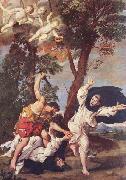 |
Domenico Zampieri
|
|
(October 21, 1581 C April 16, 1641) was an Italian Baroque painter of the Bolognese School, or Carracci School, of painters.
Domenichino was born at Bologna, son of a shoemaker, and there initially studied under Denis Calvaert. After quarreling with Calvaert, he left to work in the Accademia degli Incamminati of the Carracci where, because of his small stature, he was nicknamed Domenichino, meaning "little Domenico" in Italian. He left Bologna for Rome in 1602 and became one of the most talented apprentices to emerge from Annibale Carracci's supervision. As a young artist in Rome he lived with his slightly older Bolognese colleagues Albani and Guido Reni, and worked alongside Lanfranco, who later would become a chief rival.
In addition to assisting Annibale with completion of his frescoes in the Galleria Farnese, including A Virgin with a Unicorn (c. 1604-5), he painted three of his own frescoes in the Loggia del Giardino of the Palazzo Farnese c. 1603-04. With the support of Monsignor Giovanni Battista Agucchi, the maggiordomo to Cardinal Aldobrandini and later Gregory XV, and Giovanni??s brother Cardinal Girolamo Agucchi, Domenichino obtained further commissions in Rome. His most important project of the first decade was decoration of the Cappella dei Santissimi Fondatori in the medieval basilica of the Abbey of Grottaferrata (1608-10), some 20 kilometers outside Rome, where Odoardo Farnese was the titular abbot. Meanwhile he had completed frescoes c. 1604-05 in the church of Sant'Onofrio, feigned stucco decoration of 1606-07 in the Palazzo Mattei, a large scene of The Flagellation of St. Andrew at San Gregorio Magno, painted in competition with a fresco by Reni that faces it, and a ceiling with Scenes from the Life of Diana, 1609, in the Villa Odescalchi at Bassano di Sutri (today Bassano Romano).
Following Annibale Carracci's death in 1609, Annibale's Bolognese pupils, foremost Domenichino, Albani, Reni and Lanfranco, became the leading painters in Rome (Caravaggio had left Rome in 1606 and his followers there did not compete successfully with the Bolognese for fresco or altarpiece commissions). One of Domenichino's masterpieces, his frescoes of Scenes of the Life of Saint Cecilia in the Polet Chapel of San Luigi dei Francesi, was commissioned in 1612 and completed in 1615. Concurrently he painted his first, and most celebrated, altarpiece, The Last Communion of St. Jerome for the church of San Girolamo della Carite (signed and dated, 1614). It subsequently would be judged as being comparable to Raphael great Transfiguration and even as "the best picture in the world."
By late 1616, Domenichino had designed the coffered ceiling with The Assumption of the Virgin in Santa Maria in Trastevere; and he had begun a cycle of ten frescoes depicting the Life of Apollo in a garden pavilion of the Villa Aldobrandini (Belvedere) in Frascati, where he was assisted by Giovanni Battista Viola, a Bolognese artist who, like Domenichino himself, was a pioneer in the development of classicistic landscape painting. From 1617 until 1621, Domenichino was absent from Rome, working in Bologna and at Fano, where during 1618-19 he frescoed the Nolfi chapel of the Fano Cathedral with Scenes from the Life of the Virgin.
With the election of a Bolognese pope (Gregory XV) in 1621, Domenichino returned to Rome. Appointed Papal Architect (he built little but left drawings for various projects, most notably for the façade of Sant'Andrea della Valle and for the plan of Sant'Ignazio, both in Rome), he nonetheless continued to be most active as a painter, obtaining many commissions for altarpieces in Roman churches (San Lorenzo in Miranda, 1626-27, SS. Giovanni Evangelista e Petronio dei Bolognese, 1626-29, Santa Maria della Vittoria, 1629-30, and St. Peter's, 1625-30). He also executed numerous frescoes in Rome during the 1620s: a ceiling in the Palazzo Costaguti (c. 1622); the choir and pendentives in Sant'Andrea della Valle, where he worked in fierce competition with Lanfranco, who painted the dome above Domenichino's pendentives; and the pendentives of San Silvestro al Quirinale (c. 1628) and San Carlo ai Catinari (1628-30).
|
|
|
|
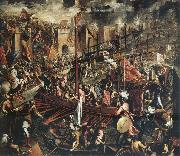 |
Domenico Tintoretto
|
|
Italian, 1560-1635,Son of Jacopo Tintoretto. He was taught by his father and assisted him in his workshop. At the age of 17 he was admitted to the Venetian painters' guild, and he is recorded in the confraternity of painters from 1594. He began his career by helping his father to execute the paintings in the Sala del Collegio and Sala del Senato in the Doge's Palace, Venice. Following this he worked independently at the palace, on the Sala dello Scrutinio and the Sala del Maggiore Consiglio. His training with his father helped him in his own compositions, several of which, such as the Battle of Salvore, or the Second Conquest of Constantinople, are heroic battle themes with complex groupings and dramatic poses. In the last two decades of the 16th century Domenico concentrated on religious commissions in Venice, including a Last Supper and Crucifixion (both c. 1583) for S Andrea della Zirada (both in situ), a Marriage of the Virgin for S Giorgio Maggiore (in situ) and a Crucifixion for the Scuola dei Mercanti.
|
|
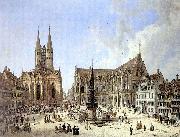 |
Domenico Quaglio
|
|
(1787-1837) was a German painter, engraver, stage designer, and architect. He was the second son of Giuseppe Quaglio and part of the large Quaglio pedigree of Italian artists involved in architecture, indoor fresco decoration, and scenography for the court theaters. He known as a landscape and architectural painter/decorator, including quadratura. He was born in Munich. He was taught perspective and scene-painting by his father, and engraving by Mettenleiter and Karl Hess. In 1819 he resigned his post as scene-painter, and occupied himself only with architecture, for which he obtained subjects in the Netherlands, Italy, France, and England. As architect in charge, Domenico Quaglio was responsible for the neogothic style of the exterior design of Hohenschwangau Castle, summer and hunting residence of King Maximilian II of Bavaria, son of King Ludwig I of Bavaria and father of King Ludwig II. Quaglio died at Hohenschwangau in 1837.
|
|
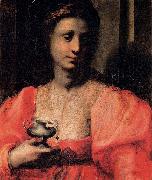 |
Domenico Puligo
|
|
(1492-1527) was an Italian painter of the Renaissance, active in Florence. His real name was Domenico di Bartolommeo Ubaldini.
He was trained by Ridolfo Ghirlandaio, but acquired a style consistent with his contemporary Andrea del Sarto. He painted a Vision of Saint Bernard altarpiece, now in Walters' Gallery in Baltimore. He was also in demand for portraits. He is featured in Giorgio Vasari's Vite or biographies of artists. He excelled as a portrait painter. He befriended Andrea del Sarto ane worked with Ridolfo Ghirlandaio. His brother, Jacone Puligo was also a Renaissance painter.
|
|
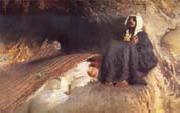 |
Domenico Morelli
|
|
Italian, 1826-1901,Italian painter and teacher. Unique among his Italian colleagues in enjoying an international reputation in his lifetime, he was, with Filippo Palizzi (see PALIZZI, (2)), the leading exponent of the Neapolitan school of painting in the second half of the 19th century and a major figure in the artistic and cultural life of Italy. His realistic treatment of Romantic subjects revitalized academic painting,
|
|
|
|
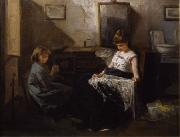 |
Domenico Induno
|
|
(1815 - 1878) was an Italian painter, originally a goldsmith.
He was born and died in Milan, and studied in the Academy of Fine Arts in Milan, as well as under Luigi Sabatelli and at Rome. He tried successively the Neoclassicism and Romantic schools, but afterwards settled down to depict popular life at Milan. In 1848 he took part with the Revolution, and had in consequence to flee to Switzerland. Thence he passed to Tuscany, and did not return home until 1859. His brother Gerolamo Induno was also a painter. Domenico married the sister of the Swiss painter Angelo Trezzini. Domenico often painted patriotic canvases, in a style indebted both to Ingres and Francesco Hayez. Among his paintings are:
|
|
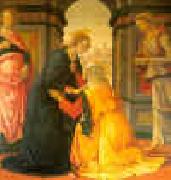 |
Domenico Ghirlandaio
|
|
Italian
1449-1494
Domenico Ghirlandaio Galleries
Painter, mosaicist and possibly goldsmith. He was head of one of the most active workshops in late 15th-century Florence. He developed a style of religious narrative that blended the contemporary with the historical in a way that updated the basic tenets of early Renaissance art. Domenico documented material situation
|
|
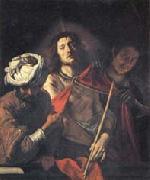 |
Domenico Fetti
|
|
Italian painter ,
Rome 1589 - Venice 1623
was an Italian Baroque painter active mainly in Rome, Mantua and Venice. Born in Rome to a little-known painter, Pietro Fetti, Domenico is said to have apprenticed initially under Ludovico Cigoli, or his pupil Andrea Commodi in Rome from circa 1604-1613. He then worked in Mantua from 1613 to 1622, patronized by the Cardinal, later Duke Ferdinando I Gonzaga. In the Ducal Palace, he painted the Miracle of the Loaves and Fishes. The series of representations of New Testament parables he carried out for his patron's studiolo gave rise to a popular specialty, and he and his studio often repeated his compositions. In August or September 1622, his feuds with some prominent Mantuans led him to move to Venice, which for the first few decades of the seventeenth century had persisted in sponsoring Mannerist styles (epitomized by Palma the Younger and the successors of Tintoretto and Veronese). Into this mix, in the 1620s?C30s, three "foreigners"??Fetti and his younger contemporaries Bernardo Strozzi and Jan Lys??breathed the first influences of Roman Baroque style. They adapted some of the rich coloration of Venice but adapted it to Caravaggio-influenced realism and monumentality. In Venice where he remained despite pleas from the Duke to return to Mantua, Fetti changed his style: his formalised painting style became more painterly and colourful.
|
|
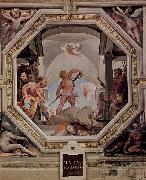 |
Domenico di Pace Beccafumi
|
|
(1486?CMay 18, 1551) was an Italian Renaissance-Mannerist painter active predominantly in Siena. He is considered one of the last undiluted representatives of the Sienese school of painting.
Domenico was born in Montaperti, near Siena, the son of Giacomo di Pace, a peasant who worked on the estate of Lorenzo Beccafumi. Seeing his talent for drawing, Lorenzo adopted him, and commended him to learn painting from Mechero, a lesser Sienese artist. In 1509 he traveled to Rome, but soon returned to Siena, and while the Roman forays of two Sienese artists of roughly his generation (Il Sodoma and Peruzzi) had imbued them with elements of the Umbrian-Florentine Classical style, Beccafumi's style remains, in striking ways, provincial. In Siena, he painted religious pieces for churches and of mythological decorations for private patrons, only mildly influenced by the gestured Mannerist trends dominating the neighboring Florentine school.
|
|
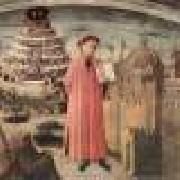 |
DOMENICO DI MICHELINO
|
|
Italian painter, Florentine school (b. 1417, Firenze, d. 1491, Firenze)
Italian painter. He took his name from his teacher, a carver in bone and ivory named Michelino. He was elected to the Compagnia di S Luca in 1442 and joined the Arte dei Medici e degli Speziali on 26 October 1444. In 1459 he received payment from Lorenzo Pucci for a processional banner (untraced) for a confraternity based in S Francesco, Cortona. Four years later he was paid for some figures of saints (untraced) for a cupboard belonging to the Compagnia di S Maria della Purificazione e di S Zanobi,
|
|
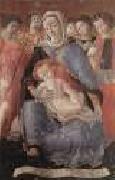 |
DOMENICO DI BARTOLO
|
|
Italian Early Renaissance Painter, 1400-ca.1447
was an Italian painter of the Sienese School. He was born in Asciano. According to Vasari, he was a nephew of Taddeo di Bartolo. He was employed by Vecchietta in the masterpiece fresco The Care of the Sick in the Pellegrinaio (Pilgrim's Hall) of the Ospedale di Santa Maria della Scala in Siena[1]. It portrays wealthy donors visiting the hospital to men washing the ill, and a fatty friar hearing confession. In 1434,
|
|
|
|
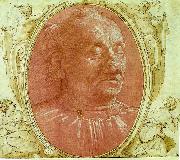 |
domenico chirlandaio
|
|
Domenico Ghirlandaio (1449 - 11 January 1494) was an Italian Renaissance painter from Florence. Among his many apprentices was Michelangelo.
Ghirlandaio's full name is given as Domenico di Tommaso di Currado di Doffo Bigordi. The occupation of his father Tommaso Bigordi and his uncle Antonio in 1451 was given as 'setaiuolo a minuto,' that is, dealers of silks and related objects in small quantities. He was the eldest of six children born to Tommaso Bigordi by his first wife Mona Antonia; of these, only Domenico and his brothers and collaborators Davide and Benedetto survived childhood. Tommaso had two more children by his second wife, also named Antonia, whom he married in 1464. Domenico's half-sister Alessandra (b. 1475) married the painter Bastiano Mainardi in 1494.
Domenico was at first apprenticed to a jeweller or a goldsmith, most likely his own father. The nickname Il Ghirlandaio (garland-maker) came to Domenico from his father, a goldsmith who was famed for creating the metallic garland-like necklaces worn by Florentine women. In his father's shop, Domenico is said to have made portraits of the passers-by, and he was eventually apprenticed to Alessio Baldovinetti to study painting and mosaic.
|
|
|
|
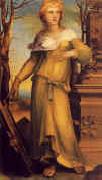 |
Domenico Beccafumi
|
|
c1486-1551
Domenico Beccafumi Gallery
Italian painter, sculptor, draughtsman, printmaker and illuminator. He was one of the protagonists, perhaps even the most precocious, of Tuscan Mannerism, which he practised with a strong sense of his Sienese artistic background but at the same time with an awareness of contemporary developments in Florence and Rome. He responded to the new demand for feeling and fantasy while retaining the formal language of the early 16th century. None of Beccafumis works is signed or dated, but his highly personal maniera has facilitated almost unanimous agreement regarding the definition of his corpus and the principal areas of influence on it. However, some questions concerning the circumstances of his early career and the choices available to him remain unanswered. The more extreme forms of Beccafumis reckless experimentation underwent a critical reappraisal only in the later 20th century.
|
|
 |
Domenico Feti
|
|
1589-1625
Italian
Domenico Feti Locations
Italian painter. Court painter to the Gonzaga family in Mantua, Feti was influenced by the chiaroscuro technique of Caravaggio. His later works, such as Melancholia (Louvre), belong, in their use of color, to the Venetian tradition.
|
|
|
|
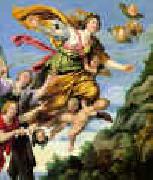 |
Domenichino
|
|
1581-1641
Italian
Domenichino Locations
Italian painter and draughtsman. On the basis of his frescoes and altarpieces he became established as the most influential exponent of the 17th-century classical style. Through his critical analysis of the art of Raphael and Annibale Carracci he was influential in the creation of a modern canon of the ancients; and he was perhaps the most complete example of a 17th-century artist struggling to reconcile tradition with the demand for spectacle.
|
|
|
|
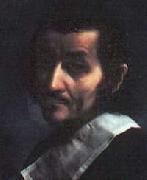 |
DOLCI, Carlo
|
|
Italian Baroque Era Painter, 1616-ca.1686
was an Italian painter of the Baroque period, active mainly in Florence, known for highly finished religious pictures, often repeated in many versions. He was born in Florence, on his mother's side the grandson of a painter. Although he was precocious and apprenticed at a young age to Jacopo Vignali, Dolci was not prolific. "He would take weeks over a single foot", according to his biographer Baldinucci.His painstaking technique made him unsuited for large-scale fresco painting. He painted chiefly sacred subjects, and his works are generally small in scale, although he made a few life-size pictures. He often repeated the same composition in several versions, and his daughter, Agnese Dolci, also made excellent copies of his works. Dolci was known for his piety. It is said that every year during Passion Week he painted a half-figure of the Saviour wearing the Crown of Thorns. In 1682, when he saw Giordano,
|
|
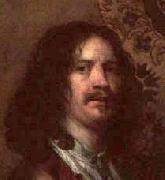 |
DOBSON, William
|
|
English Baroque Era Painter, ca.1611-1646
English painter. His father, William Dobson, was a gentleman of St Albans employed by Francis Bacon, Viscount Verulam, on the building and decoration at Verulam House and Gorhambury; he was also probably Master of the Alienation Office and a member of the Painter-Stainers' Company, but according to John Aubrey, 'he spending his estate luxuriously upon women, necessity forced his son William Dobson to be the most excellent painter
|
|
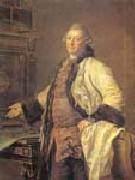 |
Dmitry Levitzky
|
|
1735-1822) was a Russian-Ukrainian portrait painter.
Dmitry was born in Kiev, Ukraine, in a family of clergyman and engraver Grigory Levitzky. His father was his first art teacher. Later be became a pupil of Aleksey Antropov who came to Kiev to paint the Cathedral of St. Andrew.
In 1770, Levitzky became famous as a portrait painter after the exhibition of six of his portraits in the Imperial Academy of Arts in St. Petersburg. For the portrait of Alexander Kokorinov, Director and First Rector of the Academy of Arts in St. Petersburg (1769) he was elected an academician and appointed the Professor of the portrait painting class at the Academy of Arts.
|
|
|
|
 |
Dirk van der Aa
|
|
Dirk van der Aa , 1731 -- February 23, 1809.
He was born in The Hague, and first apprenticed to Johann Heinrich Keller, and then to Gerrit Mes with whom he would later start a workshop; they specialized in grisaille decorative paintings. He counted Evert Morel, Cornelis Kuipers, Johan Christiaan Roedig and Andries van der Aa amongst his students. He died in his home city of The Hague.
|
|
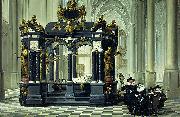 |
Dirk van Delen
|
|
(born ca. 1605 - died May 16, 1671) was a Dutch Golden Age painter.
According to Houbraken, he was born in Heusden, and was a student of Frans Hals. In 1626 he moved to Zeeland and became mayor of Arnemuiden. He specialized in architectural studies.
Shortly after he was born his parents moved to Breda. He married in Middelburg in 1625. Though he is registered in Arnemuiden from the following year until his death, he became a member of the Middelburg Guild of St. Luke from 1639-1665. In 1666 he gave a painting to the Antwerp chamber of rhetoric Olyftak, that was a collaboration with the painter Theodoor Boeyermans. In 1668 he became a member of the Olyftak. The staffage of his baroque churches has at times been attributed to other painters, such as Anthonie Palamedesz, Dirck Hals, and Pieter Codde. He died in Arnemuiden.
|
|
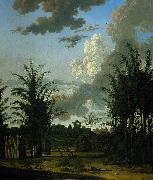 |
Dirk Valkenburg
|
|
(1675, Amsterdam - 1721, Amsterdam), was a Dutch Golden Age painter.
According to the RKD he was a pupil of Michiel van Musscher, Herman van Vollenhove, and Jan Weenix. In 1698 he worked in Vienna for the Prince of Liechtenstein, and from 1706-1707 he travelled to Surinam to draw the native plants and birds for the wealthy city secretary of Amsterdam, Jonas Witsen, who owned a plantation there and whom he met through his teacher Musscher.
He is known for exotic landscapes, paintings of birds, and fruit and flower still lifes.
|
|
|
|
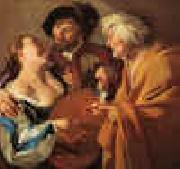 |
Dirck van Baburen
|
|
b.c. 1595, Utrecht, Netherlands.
d.Feb. 21, 1624, Utrecht
Dutch
Dirck van Baburen Gallery
|
|
 |
Dirck van Delen
|
|
1604-1671
Dutch
Dirck van Delen Location
Dutch painter. When he married in 1625 he was a citizen of Middelburg, but he settled in nearby Arnemuiden, where he became master of the toll-house. From 1628 until his death he was almost continually a member of the town council, mostly as burgomaster. He was widowed three times and had at least one son, though no children survived him. The inventory of his estate testifies that he was well-to-do.
|
|
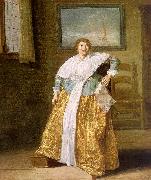 |
Dirck Hals
|
|
Dutch
1591-1656
Dirck Hals Galleries
Dirck Hals (born at Haarlem, 1591-1656) was a Dutch painter of festivals and ballroom scenes. He was influenced by his elder brother Frans Hals.
|
|
|
|
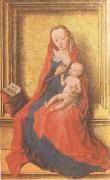 |
Dirck Bouts
|
|
Haarlem ca 1420-Louvain 1475
was an Early Netherlandish painter. According to Karel van Mander in his Het Schilderboeck of 1604, Bouts was born in Haarlem and was mainly active in Leuven (Louvain), where he was city painter from 1468. Van Mander confused the issue by writing biographies of both "Dieric of Haarlem" and "Dieric of Leuven," although he was referring to the same artist. The similarity of their last names also led to the confusion of Bouts with Hubrecht Stuerbout, a prominent sculptor in Leuven. Very little is actually known about Bouts' early life, but he was greatly influenced by Jan van Eyck and by Rogier van der Weyden, under whom he may have studied. He is first documented in Leuven in 1457 and worked there until his death in 1475. Bouts was among the first northern painters to demonstrate the use of a single vanishing point
|
|
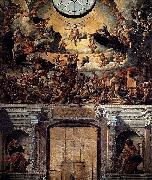 |
Dirck Barendsz
|
|
(1534?C1592) was a Dutch Renaissance painter from Amsterdam who traveled to Italy in his youth to learn from the Italian masters, most notably Titian.
|
|
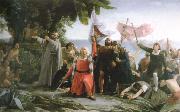 |
dioscoro teofilo puebla tolin
|
|
dioscoro teofilo puebla tolin(1831 to1901),who studied in madrid and rome,worked in the tradition fo historicism,asubgenre of history painting,which focused on the interplay of religious pride,patriotism ,and sntions of glory.tolin s technical style is referred to as eclecticism for its wide ranging,and often superficial ,borrowing from euopean techniques and visual trends. paintings in this genre were often funded by official organizations and art academies,which treated them as opportuities for propagandistic interpretations of history.the first landing of christopher columbus in america provides on shortage of drama
|
|
|
|
dioscoro teofilo de la puebla tolin
|
|
dioscoro teofilo de la puebla tolin(1831 to1901),who studied in madrid and rome,worked in the tradition fo historicism,asubgenre of history painting,which focused on the interplay of religious pride,patriotism ,and sntions of glory.tolin s technical style is referred to as eclecticism for its wide ranging,and often superficial ,borrowing from euopean techniques and visual trends. paintings in this genre were often funded by official organizations and art academies,which treated them as opportuities for propagandistic interpretations of history.the first landing of christopher columbus in america provides on shortage of drama
|
|
|
|
|
|
|
|
|
| Wholesale China Oil Painting Wholesale Oil Painting China Xiamen Portrait Reproduction on canvas Chinese Oil Painting Wholesale USA Oil Painting |
|
|
|
|
|